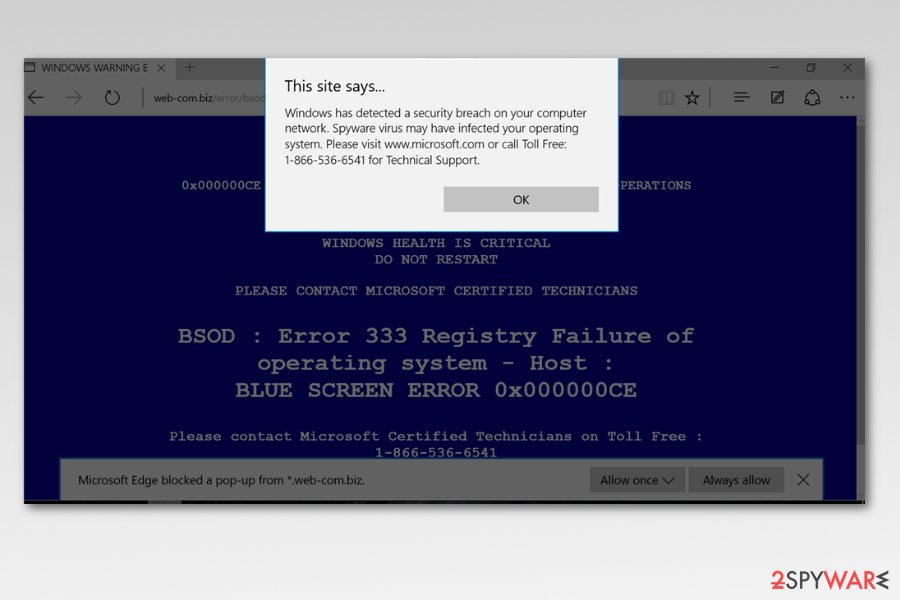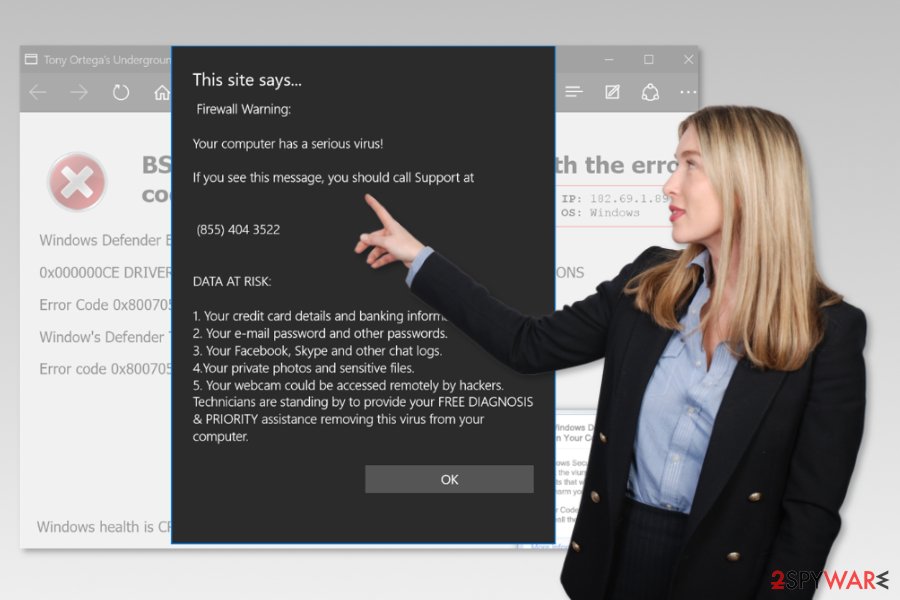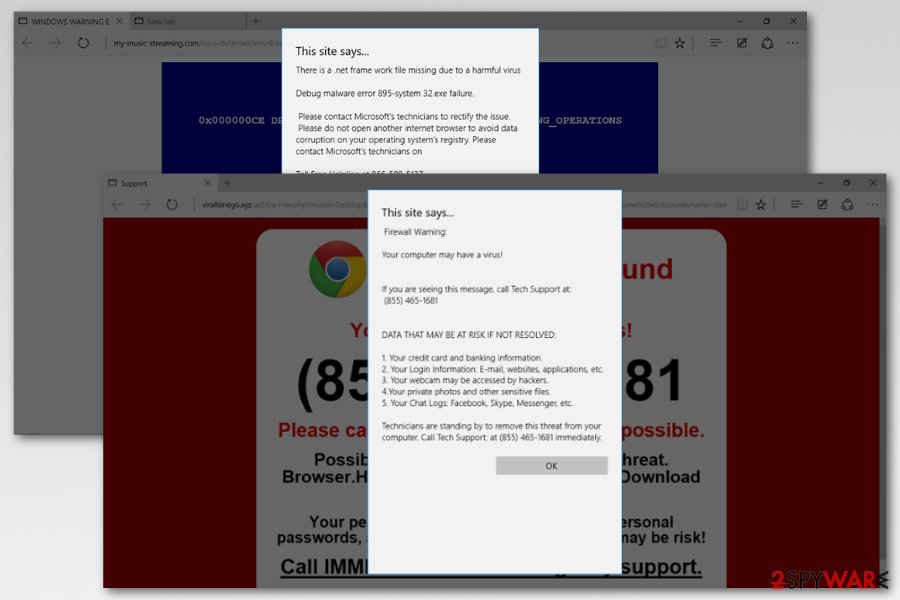
Microsoft Edge Virus +1847-306-9989 CALL NOW
Microsoft Edge Virus
Microsoft Edge Virus
Microsoft Edge virus is a term used to describe technical support scams targeting users who have Windows 10 or another OS version installed on their computers. The fake alert can be seen at any time during the web browsing sessions – it claims that users’ machines are infected with a virus and that credit card details and other personal information is being leaked by cybercriminals.
As evident, this scam comes from malicious actors who pretend to be working for this tech giant. Users are asked to call (833) 783 1868 or similar phone numbers to solve these “found issues.” However, before you grab your phone and attempt to fix nonexistent issues on your machine, keep in mind that these scammers have nothing to do with Microsoft and only seek your money or remote access to your computer. If not ignored, the scam can lead you to the loss of your personal information or infiltration of malware.
Besides tech support scams, MS Edge can also be abused for other purposes. For example, users who choose this browser can also be redirected to malicious sites by potentially unwanted programs or malware. Besides, Trojans can enable background connections that would slow down the browser significantly, as it would be spammed with endless requests to particular sites. To conclude, Microsoft Edge virus can be related to a variety of malware that needs to be taken care of as soon as possible.
| NAME | Microsoft Edge virus |
|---|---|
| TYPE | Tech support scam |
| RELATED SCAMS | Google Chrome critical error;Zeus virus detected;Congratulations Amazon user;Microsoft Warning Alert.Pornographic virus alert from Microsoft |
| MAIN WAY OF FUNCTIONALITY | Scam messages bombard its victims with constant warning alerts claiming that their data is at risk and that the only way to protect it is to call the given number |
| MAIN DANGERS | After being connected to cybercriminals, you can be tricked into downloading malware, revealing your personal information and paying for non-existent services |
| VIRUS RESPONSIBLE FOR THIS SCAM | Users start seeing scams and fake warnings after being infected with adware-type programs. Typically, these viruses are spread in a bundle with freeware |
| ELIMINATION & RECOVERY | To get rid of potentially unwanted programs, run SpyHunter 5 after downloading its latest version. You can use Reimage to eliminate post-virus issues, damaged and corrupted files. |
Special OfferREMOVE IT NOW We offer Reimage to detect damaged files. Fix them with either free manual repair or purchase the full version.More information about Reimage, Uninstall, Terms and Privacy.
Redirects to fake warning alerts typically occur after the infiltration of adware and another potentially unwanted program (PUP). However, in 2018, some compromised sites have also started showing fake alerts. In this case, you should just ignore the warning message, close the fake window and continue your browsing without visiting affected websites.
The scam not only reports about malware detected on the system. It also delivers some error codes, such as 0x8024402c (it’s a legit Windows Update error that has nothing in common with a scam), and displays a pop-up message:
Firewall Warning:
Your computer has a serious virus!
If you see this message, you should call Support at
(855) 404 3522DATA AT RISK:
1 Your credit card details and banking information.
2. Your e-mail password and other passwords.
3. Your Facebook, Skype and other chat logs.
4.Your private photos and sensitive files.
5. Your webcam could be accessed remotely by hackers.
Technicians are standing by to provide your FREE DIAGNOSIS
& PRIORITY assistance removing this virus from your computer.
However, a technical support scam website also plays an audio file. Yet, the message might not go away. It might show up every time when you open the Edge. Thus, it might replace your default startup page.
 Adware can display various bogus security alerts.
Adware can display various bogus security alerts.
In some cases, this cyber threat prevents closing this page and freezes the browser. However, you should still force-quit it and start Microsoft Edge virus removal. Bear in mind that your computer is not infected with a cyber threat that is described in the pop-up alert. Thus, calling the provided number is not needed.
People standing behind the malware might have numerous evil intentions, such as:
- tricking you into obtaining useless security software to clean your PC;
- convincing you to install remote access tools to solve the issue quickly;
- swindling personally identifiable or financial data.
Therefore, calling the fake support phone number might lead to installing a malicious program, money loss, or even identity theft. If you are bothered by this issue, remove the adware virus on your computer which is causing it. Additionally, use Reimage to fix corrupted files and similar outcomes caused by the virus.
 Microsoft Edge scam wants to trick Windows 10 users that their computers have been infected and they need to call fake support line.
Microsoft Edge scam wants to trick Windows 10 users that their computers have been infected and they need to call fake support line.
Chromium-based Edge is privacy-focused and more secure, although can still be abused by threat actors
In January 2020, Microsoft released a brand new MS Edge browser, which is based on Chromium. The new release was a great success, as Microsoft made this browser much more secure and more privacy-focused and went ahead of many of its competitors. As a result, many users decided to leave Chrome, as the latter is known to be gathering a variety of user information during their browsing sessions for profits.
Despite this, the Microsoft Edge virus prevails, even though the improved security measures of the browser can ensure that scams and other malicious websites will be encountered much less commonly. Therefore, even if you chose this brand new browser to perform your daily searches on, watch out for random popups that claim about virus infections or missing Flash Player updates – these messages are all scams and should be ignored.
If you still encountered scam messages on the Chromium-based browser, we recommend you do not ignore it, as it might be infected with adware or even malware. Do not click on anything on such fake sites, close down the tab immediately, and never download anything that is suggested. This way, you will keep your browser and computer secure and malware-free.
Software bundles and shady ads are the main methods used to spread the virus
Adware might spread using the “traditional” PUP distribution method – bundling. It means that the virus might be presented as a toolbar, browser extension, or other legitimate application and included as an optional component in the freeware or shareware bundle.
It’s easy to install PUPs unintentionally, especially if you rely on “Recommended” or rush through the “Advanced” installation guide. It’s important to use only the “Advanced” setup but follow the guide carefully because you have to read all notifications and unmark pre-selected ticks from additional download offers.
 Microsoft Edge virus is a term used to describe fake messages appearing on the hijacked web browser.
Microsoft Edge virus is a term used to describe fake messages appearing on the hijacked web browser.
Additionally, various cyber threats are hiding in online ads. Security specialists from bedynet.ru warn to stay away from advertisements that offer to download security programs, install updates or inform about detected viruses.
Removal of the Microsoft Edge virus requires restoring web browsers to their primary state
To remove the virus, you need to acquire some special knowledge related to the computer system and web browsers. If you are willing to fix your machine manually, we highly recommend resetting every web browser that you have on your computer. Additionally, you will have to find a special directory on Edge, which can be reached by using a guide below.
However, note that this cyber threat might install suspicious components that are hard to identify and terminate. Thus, security software can save time and help you succeed in virus elimination. Programs that you can choose for Microsoft Edge virus removal are given right below this article.
If you really believe that your Edge browser is infected, use the following steps. Additionally, you should find all suspicious programs, applications, and files on your computer by investigating the system.
- Open Task Manager and go to Processes Tab.
- Find Microsoft Edge process, right-click it and choose End Task option.
- Disable your Internet connection.
- Go to this directory:
C:\Users\YOUR_USERNAME\AppData\Local\Packages\Microsoft.MicrosoftEdge_xxxxxxxxxxxxx\AC\MicrosoftEdge\User\Default\Recovery\Active
NOTE. “xxxxxx” part is different from every user. - Once in this directory, delete the last folder.
You may remove virus damage with a help of Reimage. SpyHunter 5 and Malwarebytes are recommended to detect potentially unwanted programs and viruses with all their files and registry entries that are related to them.